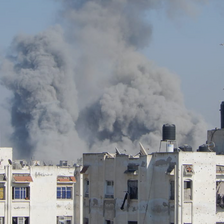The Electronic Intifada 5 January 2024

Smoke rises after an Israeli airstrike on the city of Khan Younis in the southern Gaza Strip, 7 December. (Abed Rahim Khatib / DPA via ZUMA Press)
We all get one life, but what about death? How many deaths do we get?
In Gaza, we all die more than once. Sometimes, I think we die more than we live.
On 11 October, around midnight, Israeli explosions rocked our home. Dust from the explosion filled my lungs; shrapnel flew in the air; crumbs of glass danced before us.
We could hear doors breaking, cracking.
Our home had been severely damaged from the explosions, with cracks in the walls and ceiling, and we had to get out.
My siblings and I rushed to our grandmother’s house down the street. We left with only our small bags full of essentials: cash, gold, documents.
The neighborhood streets, once familiar, were now bathed in the red glare of missiles. It felt alien and ominous.
With each dreadful explosion, we thought it was the end, and we said so out loud to each other. We raced through the explosions and prayed to God.
We arrived at my grandmother’s, but it did not feel like a safe place. We waited for the sun to rise before we could move elsewhere.
But this was a difficult task, as Gaza lacks any safe haven. We didn’t know where to go or what to do.
My second death
We went to a school run by the UN agency for Palestine refugees (UNRWA). I felt helpless, knowing that Israel would surely target these schools as well.
At 6:11 am, I heard a thunderous explosion. The building shook violently, and we scrambled to safety.
Glass littered our makeshift beds.
We all cried out to each other to make sure everyone was alive. My sister Lubna cried out for Noha, our youngest sister.
She didn’t answer. Noha was not there.
I reminded Lubna that Noha was with other relatives outside the school.
We put on our shoes because the floor was covered in glass.
What a relief it was when we met up with our brothers and knew they were safe.
We learned that the target was the house next to our window. We were lucky not to be injured; others were not lucky.
Many were injured and taken to the hospital, some in critical condition.
I saw on my phone that I had 20 missed calls, many of them from my brother Hassan.
Hassan is a doctor at Nasser Medical Complex in Khan Younis, southern Gaza. He was treating wounded people from our shelter.
He was afraid that we had been hurt.
Though we were unscathed, it still felt like death was getting closer.
My third death
At the house of our friend Sondos, we devoured our simple dinner of canned food. Israel was bombing all around us.
The building shook. Smoke filled the room, the smell of gunpowder.
Debris went flying. And, of course, the screams.
The room was filled with unbearable screams.
The Israeli occupation made the room all red and white. Red was the blood, and white was the light from the missiles.
After the panic and the rushing to safety, we froze in place. The sound of death was all around us.
My fourth death
The situation worsened, and with Israel’s imposition of communications blackouts, we had no way to contact family and friends.
Every night there were bombings, and the sky was filled with the red and white from explosions. There is suffering everywhere, but we live because there is no other choice.
Again at the shelter, the building shook in the morning. Even though this had happened before, it was just as frightening, the mix of smoke, gunpowder, shrapnel and screams.
Men, women and children rushed to safety.
Soon after, when people were buying falafel outside the school, a tent next to the falafel stand was targeted by Israel. The blast was so loud.
It killed a child named Bilal. He was 9.
Nour was kneading dough and had sent her daughters to buy falafel. She left the dough and ran to the falafel stand.
One young girl was killed, her body torn to shreds.
A 5-year-old boy was killed, his brain coming out of his skull.
A baby not even a year old was injured by shrapnel.
How was this shelter ever deemed a safe place? It is a lie.
Do not believe it.
In Gaza, there are no safe places. Israel targets us everywhere.
I do not know how I am still alive.
Donya Ahmad Abu Sitta lives in Gaza.



